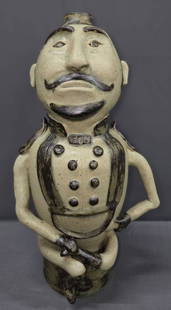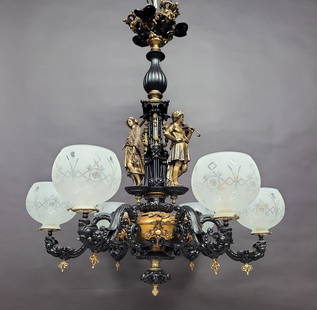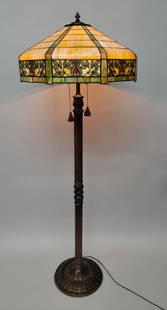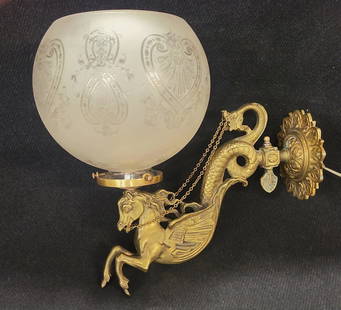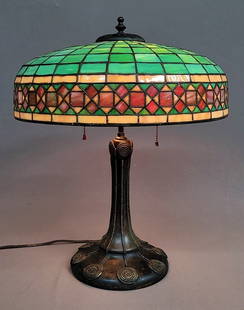
A Rare North or South Carolina "Colored Republicing Club" Stoneware Cooler
Similar Sale History
View More Items in Home & DécorRelated Home & Décor
More Items in Home & Décor
View More














Item Details
Description
A Rare North or South Carolina "Colored Republicing Club"Â Stoneware Cooler
Dated July 7, 1892
in Southern alkaline glaze, with distinctive doubled collared rim, tooled body, two lug handles set low on the body of the jar and the neck inscribed in flowing script Colored Republicing [sic] Club July 7, 1892. Height 12 3/4 inches.
Likely made by an African American potter, perhaps trained in the Edgefield District of South Carolina.
At the time this cooler was made, the power of the Black Republican vote in the south and nationally was on the decline, and Reconstruction was a rapidly fading promise. In the South, Jim Crow was squarely in the headlights. In 1892, there were 161 lynchings of African Americans, the most recorded between the beginning of Reconstruction and World War II. In the face of near continual assaults on their right to vote, this cooler represents the continued hope and unfulfilled dreams of the more than 4 million formerly enslaved.
After the Civil War, white Southerners aligned themselves with the Democratic party, while African Americans chose their liberators, the Republicans. In post war North Carolina, for example, more than half the Republican Party were Freedmen. In both North and South Carolina, in the years immediately following the War, "Republican Clubs," or "Union Leagues" were formed, and with suffrage, African Americans began to take on larger roles in local, state, and national politics. This new-found influence was short-lived as white Democrats in both states moved quickly to suppress the vote of blacks. The cooler offered here is symbolic of a period in Southern politics when African Americans became increasingly disenfranchised from the suffrage granted them by the 15th Amendment to the Constitution in 1870. Almost from the beginning of Reconstruction the National Republican party recognized the importance of the African American vote in the South and urged the formation of "colored clubs" as a means of communicating to the largely illiterate population of freedmen. The June 22, 1867, edition of the Raleigh, North Carolina Tri-Weekly Standard, for example, carried a front-page story urging African Americans ""¦to be so organized that you will act as one man, lest your enemy gain victory. You should organize Union Leagues and Republican Clubs." Accompanying the article was a proposed Constitution for these clubs specifying that officers should be elected in January and July. An online search for "Republican Club," "Colored Republican Club" and "Negro Republican Club" in North Carolina newspapers from the latter part of the 1860s until 1892 (the date of the cooler offered here) suggests such organizations were present in many portions of the state, including Hendersonville, Salisbury, New Bern, Wilmington, Raleigh, Greensboro, and Asheville. Based upon this sample, it is likely Republican Clubs were common statewide, in both large and smaller towns. A similar pattern is covered in the papers of South Carolina. Clubs were apparently present throughout the state, and in 1878 a "colored Republican club" boasted 1900 members. The date July 7, 1892, inscribed on the neck of the cooler offered here probably reflects a meeting where officers of the "Colored Republicans" were elected. Newspaper accounts from 1890 suggest that African Americans were still adhering to the Constitution first suggested in 1867. The Greensboro North State, for example, reported in the July 3, 1890, edition that the "Independent Republican Club, a negro organization formed in this city some time ago" will hold a "district convention sometime during the present month." The July 30th edition of the Wilmington Morning Star reported that the First Ward Colored Republicans met on July 22 and "reorganized with a full slate of officers."Â
By the time of the 1892 national election, the voting rights of African Americans throughout the South was under assault by whites in both the Democratic and Republican parties. Fear of “negro rule” gave way to the concept of “lily white” party membership, with the stated goal of disenfranchising Black voters in a majority of Dixie. Even nationally, the Republican party had begun to turn its back on Freedmen. At the National convention held in Minneapolis in June, Black delegates from Alabama were not seated in favor of an all-white delegation. The 100 African American delegates to the convention could not even manage to have a resolution renouncing lynching adopted in the party platform (Nathanson, 2008).
Alkaline-glazed stoneware is a uniquely Southern product. Small quantities of it were produced in southwestern Virginia and Tennessee. More of it was made in North Carolina - particularly in the state's Catawba Valley region and mountainous Buncombe County near Asheville - and in South Carolina's Edgefield District and other locales. Alkaline glazes were also employed in Georgia, Alabama, Florida, and Texas. Regardless of its maker, the cooler's alkaline glaze clearly identifies it as the product of a Southern potter. The Republican affiliation expressed on the shoulder suggests the potter was an African American. The water cooler's double rim, or collar, may be its most telling feature. Rarely seen on North Carolina alkaline-glazed stoneware jars, it is frequently found on vessels associated with South Carolina's Edgefield District - or those potters who were trained in the District. Double collars routinely appear on vessels produced by the enslaved Edgefield potter Dave Drake and turners at the Lewis Miles, Collin Rhodes and B.F. Landrum potteries. At the northern edge of the district near Kirksey's Crossroads, similar rims were produced at the Chandler potteries. Both white and black potters worked at each of these potteries, with white itinerants probably moving freely between them. At the end of the Civil War, this pattern was likely accelerated as Freedmen left their bondsmen and struck off on their own either to work as paid laborers or to start their own potteries, taking the technique with them. The double rim, for example, is found on wares made by Edgefield-born and trained Texas potter, John Leopard. South Carolina-trained potter, T. B. Odom, added double rims to his jars made in Florida at his Knox Hill pottery and later at his pottery in Upshur County, Texas. Similar rims are found on jars produced at South Carolina's Bodie pottery. Bodie potters made "well-formed ovoid jars, churns, and storage jars and unusual forms such as flasks and figural bottles "¦ Bodie jars typically [had] two opposing horizontal slab handles and a collared neck with a flared rim." (Baldwin 1993:104). In 1870, Bodie employed at least two freed black potters, Lee Rodgers and Shep Davis. After the War, Lewis Miles leased one of his Edgefield potteries to three of his former slaves, namely Willis Harrison, Pharaoh Jones, and Mark Miles. (Todd 2008:NP) Others, like Scott and Moss Miles, who may have been Lewis Miles' former slaves, reportedly worked at the B.F. Landrum pottery. Freed slaves Peter and Oliver Miles may have worked at the Seigler pottery shop. (Horne 1990:80). Former slave Josh Miles owned and operated an Edgefield pottery - perhaps the only one of its kind. (Horne 1990:81) Other black South Carolina potters known to have continued producing wares following emancipation include Jack Thurman, Milage Williams, and Thomas Jones. Ben Landrum's shop remained in operation until 1902 when it closed due to the fact that his old turners had died. (Baldwin 1993:97) To the north, the interplay between Edgefield and North Carolina potters producing alkaline glazed ware began early, with potters arriving in the Buncombe County area via the Saluda Gap Road as early as the 1820s. In the Piedmont, the concept of alkaline glaze may have been introduced in the Lincoln and Catawba counties by Edgefield-trained potters as early as the 1840s (Baldwin 1993:62-63). Given this evidence, we suggest that the cooler might have been made by a potter trained in Edgefield. The shape and distinctive body tooling, however, is unique, and as far as we have been able to determine, previously not recorded in either South or North Carolina stoneware. It is basically a modified keg shape, replete with tooling to represent the cane binding. Baldwin (1993:175) reports that both small and large kegs were made in North Carolina. Sylvanus Hartsoe of Catawba County made alkaline glazed kegs, and they appear to have been made at the Jugtown pottery of John Leonard Atkins in Greenville County, South Carolina where the form was probably introduced from North Carolina. Based upon these observations, we suggest that the cooler was made in the Piedmont or Western Mountains of North Carolina, or in South Carolina’s Jugtown area, or elsewhere in the upstate part of that state. Hindman is grateful for the contribution to this description by North Carolina ceramic scholar Stephen Compton.
Dated July 7, 1892
in Southern alkaline glaze, with distinctive doubled collared rim, tooled body, two lug handles set low on the body of the jar and the neck inscribed in flowing script Colored Republicing [sic] Club July 7, 1892. Height 12 3/4 inches.
Likely made by an African American potter, perhaps trained in the Edgefield District of South Carolina.
At the time this cooler was made, the power of the Black Republican vote in the south and nationally was on the decline, and Reconstruction was a rapidly fading promise. In the South, Jim Crow was squarely in the headlights. In 1892, there were 161 lynchings of African Americans, the most recorded between the beginning of Reconstruction and World War II. In the face of near continual assaults on their right to vote, this cooler represents the continued hope and unfulfilled dreams of the more than 4 million formerly enslaved.
After the Civil War, white Southerners aligned themselves with the Democratic party, while African Americans chose their liberators, the Republicans. In post war North Carolina, for example, more than half the Republican Party were Freedmen. In both North and South Carolina, in the years immediately following the War, "Republican Clubs," or "Union Leagues" were formed, and with suffrage, African Americans began to take on larger roles in local, state, and national politics. This new-found influence was short-lived as white Democrats in both states moved quickly to suppress the vote of blacks. The cooler offered here is symbolic of a period in Southern politics when African Americans became increasingly disenfranchised from the suffrage granted them by the 15th Amendment to the Constitution in 1870. Almost from the beginning of Reconstruction the National Republican party recognized the importance of the African American vote in the South and urged the formation of "colored clubs" as a means of communicating to the largely illiterate population of freedmen. The June 22, 1867, edition of the Raleigh, North Carolina Tri-Weekly Standard, for example, carried a front-page story urging African Americans ""¦to be so organized that you will act as one man, lest your enemy gain victory. You should organize Union Leagues and Republican Clubs." Accompanying the article was a proposed Constitution for these clubs specifying that officers should be elected in January and July. An online search for "Republican Club," "Colored Republican Club" and "Negro Republican Club" in North Carolina newspapers from the latter part of the 1860s until 1892 (the date of the cooler offered here) suggests such organizations were present in many portions of the state, including Hendersonville, Salisbury, New Bern, Wilmington, Raleigh, Greensboro, and Asheville. Based upon this sample, it is likely Republican Clubs were common statewide, in both large and smaller towns. A similar pattern is covered in the papers of South Carolina. Clubs were apparently present throughout the state, and in 1878 a "colored Republican club" boasted 1900 members. The date July 7, 1892, inscribed on the neck of the cooler offered here probably reflects a meeting where officers of the "Colored Republicans" were elected. Newspaper accounts from 1890 suggest that African Americans were still adhering to the Constitution first suggested in 1867. The Greensboro North State, for example, reported in the July 3, 1890, edition that the "Independent Republican Club, a negro organization formed in this city some time ago" will hold a "district convention sometime during the present month." The July 30th edition of the Wilmington Morning Star reported that the First Ward Colored Republicans met on July 22 and "reorganized with a full slate of officers."Â
By the time of the 1892 national election, the voting rights of African Americans throughout the South was under assault by whites in both the Democratic and Republican parties. Fear of “negro rule” gave way to the concept of “lily white” party membership, with the stated goal of disenfranchising Black voters in a majority of Dixie. Even nationally, the Republican party had begun to turn its back on Freedmen. At the National convention held in Minneapolis in June, Black delegates from Alabama were not seated in favor of an all-white delegation. The 100 African American delegates to the convention could not even manage to have a resolution renouncing lynching adopted in the party platform (Nathanson, 2008).
Alkaline-glazed stoneware is a uniquely Southern product. Small quantities of it were produced in southwestern Virginia and Tennessee. More of it was made in North Carolina - particularly in the state's Catawba Valley region and mountainous Buncombe County near Asheville - and in South Carolina's Edgefield District and other locales. Alkaline glazes were also employed in Georgia, Alabama, Florida, and Texas. Regardless of its maker, the cooler's alkaline glaze clearly identifies it as the product of a Southern potter. The Republican affiliation expressed on the shoulder suggests the potter was an African American. The water cooler's double rim, or collar, may be its most telling feature. Rarely seen on North Carolina alkaline-glazed stoneware jars, it is frequently found on vessels associated with South Carolina's Edgefield District - or those potters who were trained in the District. Double collars routinely appear on vessels produced by the enslaved Edgefield potter Dave Drake and turners at the Lewis Miles, Collin Rhodes and B.F. Landrum potteries. At the northern edge of the district near Kirksey's Crossroads, similar rims were produced at the Chandler potteries. Both white and black potters worked at each of these potteries, with white itinerants probably moving freely between them. At the end of the Civil War, this pattern was likely accelerated as Freedmen left their bondsmen and struck off on their own either to work as paid laborers or to start their own potteries, taking the technique with them. The double rim, for example, is found on wares made by Edgefield-born and trained Texas potter, John Leopard. South Carolina-trained potter, T. B. Odom, added double rims to his jars made in Florida at his Knox Hill pottery and later at his pottery in Upshur County, Texas. Similar rims are found on jars produced at South Carolina's Bodie pottery. Bodie potters made "well-formed ovoid jars, churns, and storage jars and unusual forms such as flasks and figural bottles "¦ Bodie jars typically [had] two opposing horizontal slab handles and a collared neck with a flared rim." (Baldwin 1993:104). In 1870, Bodie employed at least two freed black potters, Lee Rodgers and Shep Davis. After the War, Lewis Miles leased one of his Edgefield potteries to three of his former slaves, namely Willis Harrison, Pharaoh Jones, and Mark Miles. (Todd 2008:NP) Others, like Scott and Moss Miles, who may have been Lewis Miles' former slaves, reportedly worked at the B.F. Landrum pottery. Freed slaves Peter and Oliver Miles may have worked at the Seigler pottery shop. (Horne 1990:80). Former slave Josh Miles owned and operated an Edgefield pottery - perhaps the only one of its kind. (Horne 1990:81) Other black South Carolina potters known to have continued producing wares following emancipation include Jack Thurman, Milage Williams, and Thomas Jones. Ben Landrum's shop remained in operation until 1902 when it closed due to the fact that his old turners had died. (Baldwin 1993:97) To the north, the interplay between Edgefield and North Carolina potters producing alkaline glazed ware began early, with potters arriving in the Buncombe County area via the Saluda Gap Road as early as the 1820s. In the Piedmont, the concept of alkaline glaze may have been introduced in the Lincoln and Catawba counties by Edgefield-trained potters as early as the 1840s (Baldwin 1993:62-63). Given this evidence, we suggest that the cooler might have been made by a potter trained in Edgefield. The shape and distinctive body tooling, however, is unique, and as far as we have been able to determine, previously not recorded in either South or North Carolina stoneware. It is basically a modified keg shape, replete with tooling to represent the cane binding. Baldwin (1993:175) reports that both small and large kegs were made in North Carolina. Sylvanus Hartsoe of Catawba County made alkaline glazed kegs, and they appear to have been made at the Jugtown pottery of John Leonard Atkins in Greenville County, South Carolina where the form was probably introduced from North Carolina. Based upon these observations, we suggest that the cooler was made in the Piedmont or Western Mountains of North Carolina, or in South Carolina’s Jugtown area, or elsewhere in the upstate part of that state. Hindman is grateful for the contribution to this description by North Carolina ceramic scholar Stephen Compton.
Condition
In overall good and stable condition, with no evident cracks or repairs. Glaze chips around collar, along with one notable chip. Several minor chips around perimeter of foot. 1/2 inch hole drilled through bottom. Chip to underside of bung collar.
Buyer's Premium
- 29% up to $400,000.00
- 24% up to $4,000,000.00
- 16% above $4,000,000.00
A Rare North or South Carolina "Colored Republicing Club" Stoneware Cooler
Estimate $5,000 - $7,000
39 bidders are watching this item.
Shipping & Pickup Options
Item located in Cincinnati, OH, usSee Policy for Shipping
Payment

TOP


































